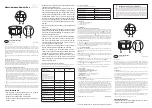
I-769N.Deluge
/ Series 769N FireLock NXT
™
Deluge Valve
/ Installation, Maintenance, and Testing Manual
DAILY/WEEKLY INSPECTION
Refer to NFPA 25, FM Datasheets, or any applicable local requirements
to perform daily/weekly inspections. The authority having jurisdiction in
the area may require these inspections on a more frequent basis. Verify
these requirements by contacting the authority having jurisdiction in the
affected area.
1.
During cold weather conditions, verify on a daily basis that the
enclosure temperature is maintained above 40° F/4° C.
2.
Inspect the valve and trim for mechanical damage and corrosion.
Replace any damaged or corroded parts.
NOTICE
• If the deluge system is equipped with a low-pressure alarm,
monthly inspections may be sufficient. Contact the local
authority having jurisdiction for specific requirements.
MONTHLY INSPECTION
Refer to NFPA 25, FM Datasheets, or any applicable local requirements
to perform monthly inspections. The authority having jurisdiction in the
area may require these inspections on a more frequent basis. Verify
these requirements by contacting the authority having jurisdiction in the
affected area.
1.
Record the system air pressure and water supply pressure.
Confirm that the water supply pressure is within the range of
normal pressures observed in the area. Significant loss of water
supply pressure could indicate an adverse condition in the water
supply. Any variations outside of the normal pressures shall be
investigated.
Ball Drip
(Step 2)
2.
Confirm that there is no leakage from the intermediate valve
chamber. The ball drip on the alarm manifold assembly should not
be leaking water or air.
3.
Inspect the valve and trim for mechanical damage and corrosion.
Replace any damaged or corroded parts.
4.
Confirm that all valves are in their normal operating positions (refer
to the table below).
Valve
Normal Operating
Position
Water Supply Main Control Valve
Open
Water Supply Main Drain Valve
Closed
System Main Drain Valve
Closed
Charge Line Ball Valve of the Priming Manifold
Assembly
Open
Alarm Test Ball Valve of the Priming Manifold
Assembly
Closed
Slow-Fill Ball Valve of the Victaulic AMTA
(if applicable)
Open
Fast-Fill Ball Valve of the Victaulic AMTA
(if applicable)
Closed
QUARTERLY INSPECTION
Refer to NFPA 25, FM Datasheets, or any applicable local requirements
to perform quarterly inspections. The authority having jurisdiction in
the area may require these inspections on a more frequent basis. Verify
these requirements by contacting the authority having jurisdiction in the
affected area.
1.
Perform the required water level (NFPA 25 priming water level)
and low air alarm tests, in accordance with Section IV of this
manual. If a high water level condition is noted during two
consecutive quarterly tests, increase the frequency of the required
water level test to monthly.
ANNUAL INSPECTION
Refer to NFPA 25, FM Datasheets, or any applicable local requirements
to perform annual inspections. The authority having jurisdiction in the
area may require these inspections on a more frequent basis. Verify
these requirements by contacting the authority having jurisdiction in the
affected area.
1.
Perform the required partial operational trip test in accordance
with Section IV of this manual.
2.
Perform an internal inspection of the deluge valve in accordance
with Section V of this manual.
3-YEAR INSPECTION
Refer to NFPA 25, FM Datasheets, or any applicable local requirements
to perform 3-year inspections. The authority having jurisdiction in the
area may require these inspections on a more frequent basis. Verify
these requirements by contacting the authority having jurisdiction in the
affected area.
1.
Perform the required full operational trip test in accordance with
Section IV of this manual.
5-YEAR INSPECTION
Refer to NFPA 25, FM Datasheets, or any applicable local requirements
to perform 5-year inspections. The authority having jurisdiction in the
area may require these inspections on a more frequent basis. Verify
these requirements by contacting the authority having jurisdiction in the
affected area.
1.
Inspect all strainers, filters, restricted orifices, and diaphragm
chambers. Replace any affected components.
I-769N.Deluge_23
REV_F
















































